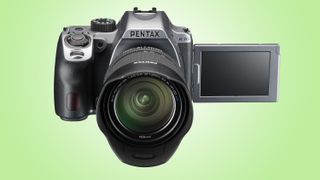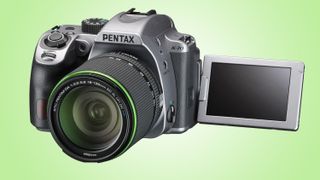TechRadar Verdict
Disappointing kit lens aside, the Pentax K-70 is a compact, solid and very well specified camera for enthusiasts that also delivers good value for money. It’s packed with innovative features, and there’s enough here to keep novices and even more experienced photographers occupied for a long time to come.
Pros
- +
Compact and rugged
- +
Hybrid live view autofocus
- +
Innovative anti-shake tech
Cons
- -
Poor kit lens performance
- -
Relatively few autofocus points
- -
Reliance on interactive display
Why you can trust TechRadar
Pentax is pitching the K-70 at the outdoor photography market, promising “new opportunities and discoveries in scenic photography”. It’s dustproof, weather-resistant and cold-resistant down to -10 degrees Celsius. There are 100 seals throughout the body, including the articulating LCD display, and the grip is designed to stay grippy even when you’re wearing gloves.
Despite all this the K-70 is still pretty compact for a fully-featured APS-C format DSLR, so it’s portable too.
And the K-70’s abilities go way beyond landscapes. Its specs and features mark it out as a rather good all-rounder, capable of taking on a much wider range of photographic subjects.
Features
- APS-C CMOS sensor, 24.2MP
- 3.0-inch, vari-angle screen, 921,000 dots
- 1080p video capture
Inside the body is a 24.2MP APS-C sensor, which is as high as APS-C format cameras go in terms of pixel count, and it has no anti-aliasing filter at the front, so the fine detail rendition should be enhanced even further.
Anti-aliasing filters are used to prevent the moiré interference patterns sometimes seen when photographing fine textures or patterns with a digital sensor’s rectangular array of photosites. These filters work by slightly blurring fine detail, and then leaving the camera to sharpen it up again digitally. When you take away the filter the fine detail should be sharper but you risk, moiré in some shots (although actually it doesn’t seem to be a problem in most real-life photography).
Pentax has a clever solution for this, with a unique ‘AA Filter Simulator’. This applies microscopic vibrations at a sub-pixel level during the exposure to simulate the effect of a ‘real’ anti-aliasing’ filter. You may not need it, but it’s there if you do.

This is just one of the tricks made possible by Pentax’s 5-axis Sensor Shift (SR) system. Its most obvious use is to cut camera shake when using slower shutter speeds – Pentax claims a gain of up to 4.5 shutter speed steps. That compares well with the best lens-based stabilization systems, but making the sensor, rather than the lens ‘stabilized’ has advantages – it offers a wider range of correction movements, and it should work with practically any lens.
It doesn’t stop there. Pentax also uses this sensor-shift system for its clever Pixel Shift Resolution mode, for better color rendition and definition in ultra-fine detail. This works by combining four separate shots taken in quick succession, so it works best on a tripod with static subjects, but Pentax has now added a Motion Correction feature, which detects and compensates for any moving objects.
Last but not least is an Astrotracer feature also seen on the pro-level Pentax K-1. This uses GPS data and the camera’s sensor-shift system to keep celestial objects in the night sky completely stationary, so they don’t turn into streaks of light. You will need a GPS receiver for this, though, which is an optional extra on this camera.
The K-70 is pretty well specified in other respects too. It offers sensitivity up to ISO102,400, a maximum shutter speed of 1/6000 sec, which is halfway between the top speeds of most rivals and those of pro cameras, and a clever Bulb Timer function for ultra-long exposures of up to 20 minutes.

The rear screen has a flip-out vari-angle mechanism, which already makes it pretty useful, but the promise of faster live view autofocus makes it better still. You can also use it for shooting video, of course, although the K-70 stops at full HD (1920 x 1080) resolution, so if you want 4K you’re going to have to look elsewhere – although it will shoot 4K timelapse movies.
The K-70 gives you a lot to take in. You might never use all the features it offers, but for keen photographers who want to learn new techniques and effects, it’s perfect.

